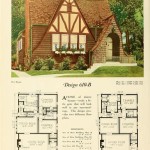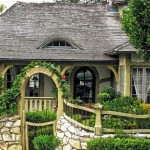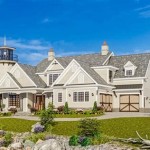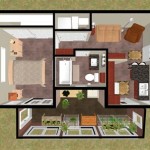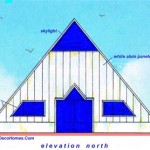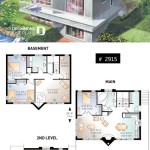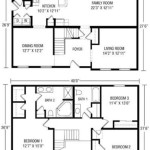House plans with enclosed courtyards are architectural designs that incorporate an inner courtyard within the home’s structure. This enclosed outdoor space typically serves as a private oasis, providing natural light, ventilation, and a connection to nature. An example of a house plan with an enclosed courtyard is the “Courtyard House” by architect Luis Barragn, where the central courtyard forms a core element of the home’s design and living experience.
Enclosed courtyard plans offer numerous advantages. They allow homeowners to enjoy the benefits of both indoor and outdoor living, creating an intimate and inviting space for relaxation, entertainment, or gardening. Additionally, enclosed courtyards can enhance natural lighting and ventilation within the home, reducing energy consumption and improving overall well-being.
In the following sections, we will delve into the various aspects of house plans with enclosed courtyards, exploring their benefits, design considerations, and inspiring examples that showcase the unique possibilities of this architectural concept.
Enclosed courtyard house plans offer a range of benefits and design possibilities. Here are 8 key points to consider:
- Enhanced natural light
- Improved ventilation
- Private outdoor space
- Reduced energy consumption
- Increased property value
- Adaptable to different climates
- Versatile design options
- Enhanced indoor-outdoor connection
Enclosed courtyard house plans offer a unique blend of indoor and outdoor living, providing homeowners with a private sanctuary and a connection to nature within the confines of their own home.
Enhanced natural light
Enclosed courtyards act as light wells, drawing natural light deep into the home’s interior. The courtyard’s reflective surfaces, such as white walls or light-colored paving, bounce sunlight into the surrounding rooms, illuminating spaces that would otherwise be dark or rely on artificial lighting.
The amount of natural light entering the home can be controlled through the size and placement of openings in the courtyard walls. Larger openings allow for more light penetration, while smaller openings provide more privacy and control over direct sunlight. Skylights or clerestory windows can also be incorporated into the courtyard design to capture additional daylight from above.
By maximizing natural light, enclosed courtyards reduce the need for artificial lighting during daytime hours, leading to energy savings and a more sustainable living environment. Natural light has also been shown to have positive effects on mood, productivity, and overall well-being.
Furthermore, the presence of natural light in the courtyard creates a more vibrant and inviting space, making it an attractive focal point for indoor-outdoor living and entertaining.
Improved ventilation
Enclosed courtyards play a crucial role in improving natural ventilation within the home. The courtyard acts as a central core that facilitates the flow of fresh air throughout the interior spaces.
- Cross ventilation
Courtyards create opportunities for cross ventilation by allowing air to enter from one side of the courtyard and exit from the other. Openings in the courtyard walls, such as windows, doors, and vents, facilitate the movement of air. This cross ventilation helps to circulate fresh air throughout the home, removing stale air and reducing the buildup of moisture and pollutants.
- Stack effect
The stack effect is a natural phenomenon that occurs when warm air rises and cooler air sinks. In an enclosed courtyard house, the courtyard acts as a thermal chimney. Warm air from the interior spaces rises into the courtyard, creating a low-pressure area that draws fresh air in from the lower levels of the home. This creates a continuous flow of fresh air, ventilating the home naturally.
- Passive cooling
Courtyards can also contribute to passive cooling strategies. During hot summer months, the courtyard can be shaded to reduce solar heat gain. The cooler air in the courtyard then helps to cool the surrounding rooms through conduction and convection. Additionally, evaporative cooling can occur when water features, such as fountains or ponds, are incorporated into the courtyard design.
- Improved air quality
Enclosed courtyards can help to improve indoor air quality by providing a space for plants and other natural elements. Plants absorb carbon dioxide and release oxygen, contributing to a healthier indoor environment. Additionally, the natural ventilation facilitated by the courtyard helps to reduce the accumulation of pollutants and allergens, creating a more comfortable and healthier living space.
Overall, enclosed courtyards are an effective way to improve ventilation in the home, reducing the reliance on mechanical ventilation systems and creating a more comfortable and healthy indoor environment.
Private outdoor space
Enclosed courtyards offer a private and secluded outdoor space within the confines of the home. Unlike traditional backyards, which may be overlooked by neighbors or lack privacy, enclosed courtyards are designed to create a sense of intimacy and seclusion.
Courtyard walls and fencing provide visual and physical barriers, shielding the outdoor space from prying eyes and creating a private sanctuary for relaxation, entertainment, or simply enjoying the outdoors. This privacy allows homeowners to fully embrace outdoor living without sacrificing their comfort or security.
Enclosed courtyards can be customized to suit the specific needs and preferences of the homeowners. Whether it’s a cozy seating area for intimate gatherings, a dining space for al fresco meals, or a play area for children, enclosed courtyards offer the flexibility to create a private outdoor oasis tailored to the homeowner’s lifestyle.
Private outdoor spaces have been shown to provide numerous benefits, including reduced stress, improved mood, and increased physical activity. By providing a secluded and inviting space to connect with nature, enclosed courtyards enhance the overall well-being of the home’s occupants.
Reduced energy consumption
Enclosed courtyards can contribute to reduced energy consumption in several ways:
- Improved thermal insulation
Enclosed courtyards act as thermal buffers, reducing heat loss in winter and heat gain in summer. The courtyard walls and roof provide an additional layer of insulation, helping to maintain a more stable indoor temperature. This reduces the need for heating and cooling systems, leading to lower energy consumption and utility bills.
- Passive solar heating
During winter months, enclosed courtyards can be designed to capture passive solar heat. Large windows or glazed openings on the south-facing side of the courtyard allow sunlight to enter and warm the courtyard space. This heat is then absorbed by the surrounding walls and radiated into the interior of the home, reducing the need for artificial heating.
- Natural ventilation
As discussed earlier, enclosed courtyards facilitate natural ventilation, reducing the reliance on mechanical ventilation systems. By allowing fresh air to circulate naturally, enclosed courtyards help maintain a comfortable indoor temperature without the need for excessive energy consumption.
- Daylighting
Enclosed courtyards can provide natural daylighting to interior spaces, reducing the need for artificial lighting during daytime hours. The reflective surfaces of the courtyard walls bounce sunlight into the surrounding rooms, illuminating spaces that would otherwise require electric lighting. This can lead to significant energy savings on lighting costs.
Overall, enclosed courtyards offer a sustainable and energy-efficient design solution by reducing the need for artificial heating, cooling, ventilation, and lighting, resulting in lower energy consumption and a more environmentally friendly home.
Increased property value
Enclosed courtyard house plans can significantly increase the property value of a home due to several factors:
- Enhanced curb appeal
Enclosed courtyards create a visually appealing and inviting entrance to the home. The private and secluded nature of the courtyard, combined with its aesthetic appeal, enhances the overall curb appeal of the property, making it more attractive to potential buyers.
- Increased living space
Enclosed courtyards essentially extend the living space of the home by providing an additional outdoor area that can be used for various purposes. This increased living space adds to the overall value of the property, as it offers more space for relaxation, entertainment, or simply enjoying the outdoors.
- Improved functionality
Enclosed courtyards offer a range of functional benefits, such as improved natural lighting, ventilation, and privacy. These features enhance the overall livability and comfort of the home, making it more desirable to potential buyers and increasing its value.
- Unique design feature
Enclosed courtyard house plans are still relatively unique and offer a distinctive design feature that sets the property apart from others in the neighborhood. This unique design element can increase the property’s perceived value and make it more appealing to buyers looking for a home with character and personality.
In addition to these factors, enclosed courtyards can also increase property value by providing potential for future development. The courtyard space can be used to add additional rooms or structures, such as a guest house, studio, or pool, further increasing the value of the property.
Overall, enclosed courtyard house plans offer a number of benefits that can significantly increase the property value of a home, making it a wise investment for homeowners.
Adaptable to different climates
Enclosed courtyard house plans offer a versatile design solution that can be adapted to suit different climates and geographic locations. By incorporating climate-responsive design strategies, enclosed courtyards can provide a comfortable and energy-efficient living environment in various climatic conditions.
- Hot and arid climates
In hot and arid climates, enclosed courtyards can be designed to provide shade and reduce heat gain. Courtyard walls can be constructed with thick, heat-absorbing materials, such as stone or adobe, to minimize heat penetration. Overhanging roofs, trellises, or awnings can be incorporated to shade the courtyard from direct sunlight. Water features, such as fountains or ponds, can also be used to cool the air through evaporative cooling.
- Cold and temperate climates
In cold and temperate climates, enclosed courtyards can be designed to maximize solar heat gain and reduce heat loss. Courtyard walls can be constructed with materials that have high thermal mass, such as concrete or brick, to absorb and store heat from the sun. Large windows or glazed openings on the south-facing side of the courtyard can allow sunlight to enter and warm the courtyard space. Thermal curtains or blinds can be used to retain heat during the night.
- Humid climates
In humid climates, enclosed courtyards can be designed to promote natural ventilation and reduce moisture buildup. Courtyard walls can be constructed with moisture-resistant materials, such as tile or stucco, to prevent water penetration. Openings in the courtyard walls, such as windows, doors, and vents, can be placed to facilitate cross ventilation and allow moisture to escape.
- Coastal climates
In coastal climates, enclosed courtyards can be designed to withstand high winds and salt spray. Courtyard walls can be constructed with durable materials, such as concrete or stone, to resist strong winds. Openings in the courtyard walls can be fitted with hurricane shutters or impact-resistant windows to protect against flying debris. Plants and other landscaping elements within the courtyard can be selected to tolerate salt spray and coastal conditions.
By considering the specific climatic conditions and incorporating appropriate design strategies, enclosed courtyard house plans can be adapted to provide a comfortable and sustainable living environment in a wide range of locations.
Versatile design options
Enclosed courtyard house plans offer a multitude of versatile design options that allow homeowners to customize their living space to suit their unique needs and preferences. From the choice of materials and architectural styles to the layout and integration of indoor and outdoor elements, enclosed courtyards provide a flexible canvas for creative design.
- Courtyard shape and size
Enclosed courtyards can vary greatly in shape and size, from small, intimate spaces to large, expansive courtyards that serve as the focal point of the home. The shape and size of the courtyard should be carefully considered based on the available space, desired functionality, and overall design concept.
- Architectural style
Enclosed courtyards can be incorporated into a wide range of architectural styles, from traditional to modern and contemporary. The architectural style of the courtyard should complement the overall design of the home, creating a cohesive and visually appealing living environment.
- Materials and finishes
The choice of materials and finishes for the enclosed courtyard is crucial in determining its aesthetic appeal and functionality. Materials such as stone, tile, concrete, and wood can be used to create different textures, colors, and patterns, adding visual interest and character to the space.
- Landscaping and
Landscaping and play a vital role in enhancing the beauty and functionality of enclosed courtyards. Plants, trees, and water features can be incorporated to create a serene and inviting outdoor oasis. Careful consideration should be given to plant selection, placement, and maintenance to ensure a thriving and visually appealing courtyard.
The versatility of enclosed courtyard house plans allows homeowners to create unique and personalized living spaces that cater to their specific needs and desires. By combining different design elements and materials, enclosed courtyards can be transformed into private sanctuaries, outdoor entertainment areas, or simply beautiful extensions of the indoor living space.
Enhanced indoor-outdoor connection
Enclosed courtyard house plans offer a unique opportunity to enhance the connection between indoor and outdoor living spaces. By blurring the boundaries between the interior and exterior, enclosed courtyards create a seamless flow of space, allowing homeowners to fully embrace outdoor living and bring the beauty of nature into their homes.
Large windows, sliding glass doors, or retractable walls can be incorporated into the courtyard design, providing unobstructed views of the outdoor space from the interior. This visual connection allows natural light to penetrate deep into the home, creating a bright and airy atmosphere. The open and inviting layout encourages residents to move effortlessly between indoor and outdoor areas, fostering a sense of connection with the natural surroundings.
Enclosed courtyards can also serve as an extension of the living space, offering additional areas for relaxation, entertainment, or dining. Outdoor furniture, fireplaces, and water features can be incorporated into the courtyard design, creating a comfortable and inviting environment for outdoor living. The private and secluded nature of enclosed courtyards allows homeowners to enjoy the outdoors without sacrificing privacy or security.
Furthermore, enclosed courtyards can be designed to create microclimates that extend the outdoor season. By incorporating elements such as shade trees, pergolas, or windbreaks, homeowners can create comfortable outdoor spaces that can be enjoyed throughout the year. This enhanced indoor-outdoor connection not only expands the living space but also promotes a healthier and more active lifestyle by encouraging residents to spend more time outdoors.
Overall, enclosed courtyard house plans offer a unique and innovative way to enhance the indoor-outdoor connection. By blurring the boundaries between interior and exterior spaces, enclosed courtyards create a seamless flow of space, allowing homeowners to fully embrace outdoor living and bring the beauty of nature into their homes.

/cdn.vox-cdn.com/uploads/chorus_image/image/58794619/auhaus_architecture_modern_courtyard_home_australia_9.0.jpg)








Related Posts

